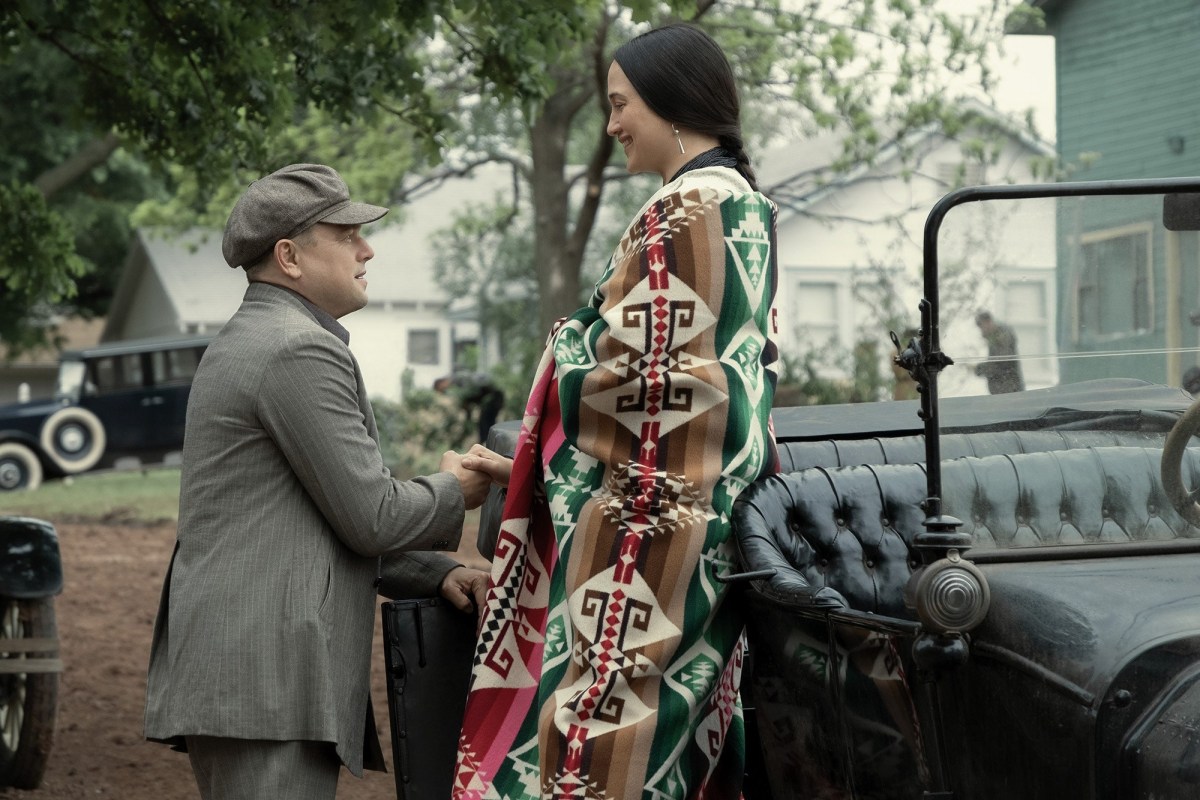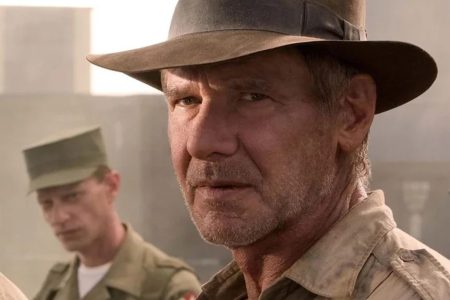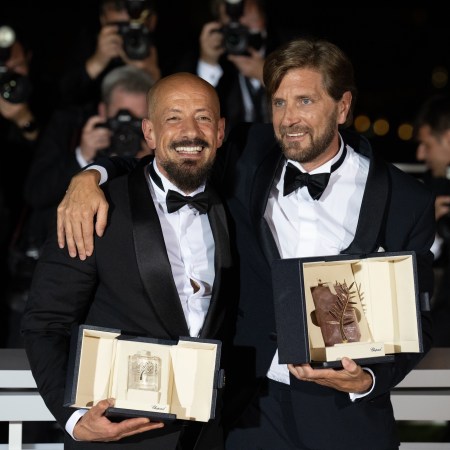This is the third installment of the 2023 edition of the French Dispatches, our on-the-ground coverage of the Cannes Film Festival.
There’s a shot not quite 20 minutes into Martin Scorsese’s 1992 adaptation of The Age of Innocence that, through a combination of sets and matte paintings, shows upper Manhattan as it would have looked in the Gilded Age: as a vast open plain, dotted with the first few of the mansions that would soon fill in the street grid. It’s almost like a shot from a Western — New York City in this moment seems a wild place still to be claimed, settled, defined. But of course the streets have already been laid out, the territory has been mapped and the city planned, and Age of Innocence, about how the brutal strictures of high society thwart thwart the desires of the characters by imposing a preordained script on their lives, shows how power has already shaped this brave new world.
I thought of that shot early on in Scorsese’s new, wonderful Killers of the Flower Moon — set in the 1920s, the decade Edith Wharton wrote The Age of Innocence — which had its world premiere on Saturday out of competition in Cannes in the Lumière, about an hour and a half after about 1,000 of the luckiest film critics in the world took our seats for the press screening in the Debussy. Very early in Killers, a train pulls into an Oklahoma station around which a town has sprung up. From camera in the sky, swooping like a bird, we see an expansive vista, dotted with new buildings. The epic beauty of the American landscape, as far as the eye can see, and the traces of hardy human endeavor making the beginnings of a civilization from it — it’s the visual grammar of the Western genre, the great American myth of the conquest of the virgin frontier, which was, of course, nothing of the sort. Scorsese, who has made many films about the allure and the souring of myths — of masculinity, of the Mafia, of money — here tells the story of a series of murders of members of the oil-rich Osage nation, who were killed because they had resources the white man wanted, which is a story as old as America itself.
On that train pulling into Oklahoma is Leonardo DiCaprio, as Ernest Burkhart, one of the central figures in the David Grann nonfiction book on which the film is based. Aided by some ugly prosthetic teeth that make his smile look ratty and dumb, DiCaprio sinks into the role of a man who thinks he’s more handsome, charming and clever than he is (a blithe self-confidence which is its own kind of char). A Great War veteran come West to seek his fortune, Ernest is not a self-made man, more a nepo adult, who finds work for his uncle, William Hale, a rancher and grandee of Osage county, played by Robert De Niro (he tells Ernest not to call him uncle; call him “King”). An ostentatious friend to the Native community, who raises his hands to the sky and chants in unsubtitled Osage language when he wants to be especially demonstrative, King is also very shrewd about the economics of the area, where an oil strike on tribal land has made the Osage wealthy — has given this indigenous population what we would now call a source of passive income, which King encourages Ernest to marry into. He picks Mollie Kyle (Lily Gladstone) and enters into a mixed marriage somewhat reminiscent of the one between Henry and Karen Hill in Goodfellas, which, also like the Hills’ marriage, is compromised by Ernest’s loyalties outside of the marriage to his criminal associates, and the variously untrustworthy and incompetent people to which crime is outsourced. Ernest’s slide into crime against the Osage — not the murders, initially, just small-scale stuff — happens so casually you may think you missed a scene somewhere along the way; the editing, by Scorsese’s perpetual right hand Thelma Schoonmaker, seals off little bits of trauma for later, as if mirroring the lies Ernest tells himself about his complicity in the crimes against his wife and her family. Like The Irishman, the film is, among other things, about the tragedy of a man who was too stupid and greedy to realize he could have chosen love if he had wanted to.
If Goodfellas undercut and critiqued the type of gangster narrative that was, in the ’30s, associated with immigrant striving, showing its dreams of assimilation through accumulation as petty and venal rather than darkly heroic underdog stories, Killers of the Flower Moon, his Western, similarly upends a kind of thinking that’s always been embedded in the Western. Scorsese has only previously dabbled in the Western form — Goodfellas has Joe Pesci reenact the last shot of The Great Train Robbery, the first Western blockbuster, and of course Taxi Driver borrows liberally from The Searchers and its obsession with the purity of white women and cleansing violence — but such a foundational genre, our national epic, is an implicit element in the films of the man who for many is synonymous with American cinema. Killers is set decades after The Great Train Robbery was made, and handles much of its exposition by mocked-up newsreels; photographers have set up portraits in Osage Nation, making money by memorializing Indigenous families in traditional clothes; the story of the Osage murders is told on the radio. There is a whole emergent form of mass-media storytelling springing up at the same time as these murders — a media which would consolidate the American story around heroic tales of cowboys and Indians (cowboys such as the well-known rodeo rider who was involved in the murders) and ignore this story for 100 years. American cinema is deeply implicated in in the events of Killers of the Flower Moon, which means Scorsese is too, and his choices here indicate that he knows this. The film is a multilayered historical and metacinematic consideration of who, exactly, are “the hands that built America,” to quote the U2 song from the flash-forward ending of Gangs of New York, another Scorsese film about racial prejudice and nation-building.
If Gangs is Scorsese’s version of Sergio Leone’s Once Upon a Time in America, about blood loyalties and immigrant striving and ethnic New York City, then Killers is his Once Upon a Time in the West, about settler-capitalist will-to-power. Yet in both films there’s sense of fable, of Once Upon a Time, evoked through massive sets and movie magic. Killers is Scorsese’s most Leonian film since Gangs, with subtly heroic angles and widescreen compositions. Jack Fisk’s production design features the grandest Old West main street, that former backlot staple, seen onscreen in many a moon; there are Victorian rancher mansions out on the edge of the world and widescreen interiors as big as the outdoors. This is a West that is bigger than life, a dream of the West; much of the film’s grandiosity also comes from powerhouse showdowns between the actors. DiCaprio and De Niro, Scorsese’s two great leading men, act together for him for the first time in scenes fraught with generational consequence (and also reminiscent of the dynamics between De Niro and Ray Liotta in Goodfellas, and DiCaprio and Daniel Day-Lewis in Gangs, the desire to please, to embody, to betray the father). But the best performance in the film — one of the performances of the year, or any year — comes from Lily Gladstone. Carrying the weight of a century and more of compromised Native representation on film, she imbues Mollie with a stoicism and grace, as well as a fundamental innocence and openness — throughout the film, she looks at DiCaprio like she can see the best part of him, an unturning gaze that becomes sadder and sadder as that part gets farther and farther away. Her performance, so vivid you can almost reach through the screen and touch her, reminds you that this archetypal American story is still being written, and rewritten, today.
Can an “Indiana Jones” Movie Work Without Steven Spielberg?
“Indiana Jones and the Dial of Destiny” brought nostalgia and a sense of looming mortality to CannesAnother, very different kind of American myth-making is the subject Todd Haynes’s May December, which premiered a few hours later on Saturday night. The film stars Julianne Moore and Charles Melton (television’s Hot Reggie) as a fiftysomething wife and her thirtysomething husband; the two were a supermarket-tabloid item in the ’90s, when the married suburban mom Gracie took up with the then-13-year-old Joe, and now, in the present day, Elizabeth Berry (Natalie Portman) has come to uneasily insinuate herself into their lives, part of her preparation to play Gracie in an upcoming film. The new film, everyone says, will be nothing like the tawdry made-for-tv quickie previously made in the ’90s; this one will be respectful, unsensational, nuanced, like one of the feminist-revisionist streaming documentaries on ’90s celebrities so in vogue at the moment, an uneasy mix of sugary rubbernecking exploitation and nutrient-rich empathy.
Haynes has made movies reflecting on entertainment-industry mediation of true crime before, notably in the “Hero” segment of his early-’90s breakthrough Poison, which parodied the now-disreputable Hard Copy true-crime style to tell a story of trauma and transcendence. May December is a mix of campy zooms and raw nerves, of sharp laughs and genuine pathos; both are present in Moore’s daring, lisping performance as the brittle perfectionist and permanent daddy’s girl Gracie, who, like the housewives Moore played in Haynes’s [safe] and Far from Heaven, tries to use domesticity to fit into the world, and shield herself from it. Gracie’s performance of femininity gains an extra layer from the presence of Elizabeth, here to interrogate and imitate Gracie’s younger self — there are a lot of mirror shots in this movie, because how could there not be, and the almost-seductive charge between the two women as they observe each other, informed by the fact of Elizabeth’s celebrity and of Gracie’s notoriety, plugs into a deep American zeitgeist, the desire to be understood and the fear of being truly seen.
In Far from Heaven, Haynes drew from the classic melodramas of Douglas Sirk, using devices including lyrical, obvious nature symbolism in the opening and closing credits; he repeats the trick here, threading animal motifs throughout the film — Gracie and Joe met in a pet shop, while Elizabeth isn’t a veterinarian but she plays one on TV, and Joe keeps caterpillars, which eventually transform into butterflies and soar away from their cage. While Far from Heaven re-enacted the visual grammar of classic Sirkian melodrama to tell a more modern story, Haynes of late (especially via the strip-mall luminosity of the underrated Dark Waters) has been interested in creating a new kind of stylized melodramatic look from the raw materials of contemporary upper-middle-class consumer society. Gracie and Joe’s McMansion is on the water, with lots of windows, and Haynes and cinematographer Christopher Blauvelt use the light and the space to create a shimmering, emotionally expressive, hyperreal look that’s still within the film language and familiar interiors of a Lifetime Original, with Sirkian lighting effects through double-glazed French doors instead of stained glass.
Haynes has made films about uneasily married women before, most notably his previous films with Moore; and he’s made films with radical narratives which examine how celebrities are perceived in the public eye, like Superstar, Velvet Goldmine and I’m Not There. Gracie’s central relationships in the film, with her husband Joe and her pop-culture interpreter Elizabeth, gives May December elements of both, and makes it a unified and multifaceted work about what it’s like to be defined and perceived through, by and in relation to others. (Elizabeth says her parents were academics; her mother wrote a book on “epistemic relativism.”) And it’s funny as hell — wait for Elizabeth’s reaction when she watches her prospective costars’ screen tests. I was enthralled, surprised and then gratified to see May December enter the Screen International critics grid with the highest grade so far in the competition.
Killers and May December were, really, if I’m honest myself, all I needed from Cannes this year, so although it’s been a pretty uniformly strong Competition so far my impressions of the festival are of a slow start and a long anticlimax, leading up to 4:30 p.m. on Saturday afternoon, when Killers of the Flower Moon started, and ending at 1 a.m. that night, when May December finished. In between, though, I saw maybe the most daring and divisive film of the festival, Zone of Interest, the fourth feature by Jonathan Glazer, whose previous film, 2013’s Under the Skin, was the most surprising, formally impressive, intellectually dubious film of the festival 10 years ago, as Zone of Interest is of this one.
Under the Skin starred Scarlett Johansson as an alien who falls to earth to seduce and consume men, and the film, directed with minimal exposition, hidden cameras and a brooding atonal score by Mica Levi, gave the impression of a cruel and curious remove. Zone of Interest is even chillier. Loosely adapted from the novel by Martin Amis — who died the day of the film’s premiere — it’s set at Auschwitz, or rather, more particularly, at the home of Auschwitz commander Rudolf Höss. The house is large and graciously appointed, with a vast, frankly Edenic garden; ivy grows up the sides of the concrete walls bordering the camp, and sometimes, just barely, you can hear the noises from the other side, or see the smoke rising from the crematoria, intruding, just barely, on the edge of your consciousness.
Höss’s hausfrau Hedwig is house-proud and status-conscious; the great German actress Sandra Hüller portrays her with matronly efficiency, girlish pride in the work of the servants in keeping such a fine home, and, when her husband announces he is to be transferred and they may have to give up the property, monstrous entitlement and insecurity.
She does all this without acting for the camera at all. The film is shot in digital deep focus from hidden-camera positions in the corners of rooms and along the edges, angled for maximum coverage and objectivity, always outside rather than within the action; scenes are played continuously to multiple cameras, with cutting on dialogue, to clearly identify the speaker, and on movement, to track their perambulations from room to room. The most obvious stylistic comparison is live sports, with a director in the control room cutting between cameras to keep your eye on the ball; the creepy implication is of an invisible observer gathering data on human specimens.
The action is deliberately banal and contrapunctual to the realities of the Holocaust: Rudolf’s sweet birthday toast with his kids, daily chores, the visit of Hedwig’s mother, the bureaucratic small-mindedness inherent in the day-to-day implementation of the Final Solution (an observation that dates back to Hannah Arendt’s Eichmann in Jerusalem and everybody’s favorite quote about the mindset of the Nazis), and the occasional matter-of-fact atrocity the gravity of which you have to figure out for yourself, like when Hedwig tries on a new fur coat and you realize it was taken off a Jewish woman who just came in on the last train. There’s no music, only ambient sound.
Glazer’s frankly inhumanly withholding direction, which (mostly) absolutely refuses to goose or manipulate, is of course its own form of manipulation; that he is so evidently unmoved by the horrors he stages is actually a way of underscoring them. It’s hard to tell whether you’re supposed to feel more cowed by the absolute formal virtuosity or by the slowly accumulating terror, or if you’re even supposed to be able to tell the difference. Zone of Interest is experientially vivid, to the point of overwhelming, and certainly makes the naked sociopathology of human power relations feel newly vivid, if for whatever reason you ever find yourself in need of a reminder.
This article appeared in an InsideHook newsletter. Sign up for free to get more on travel, wellness, style, drinking, and culture.

























